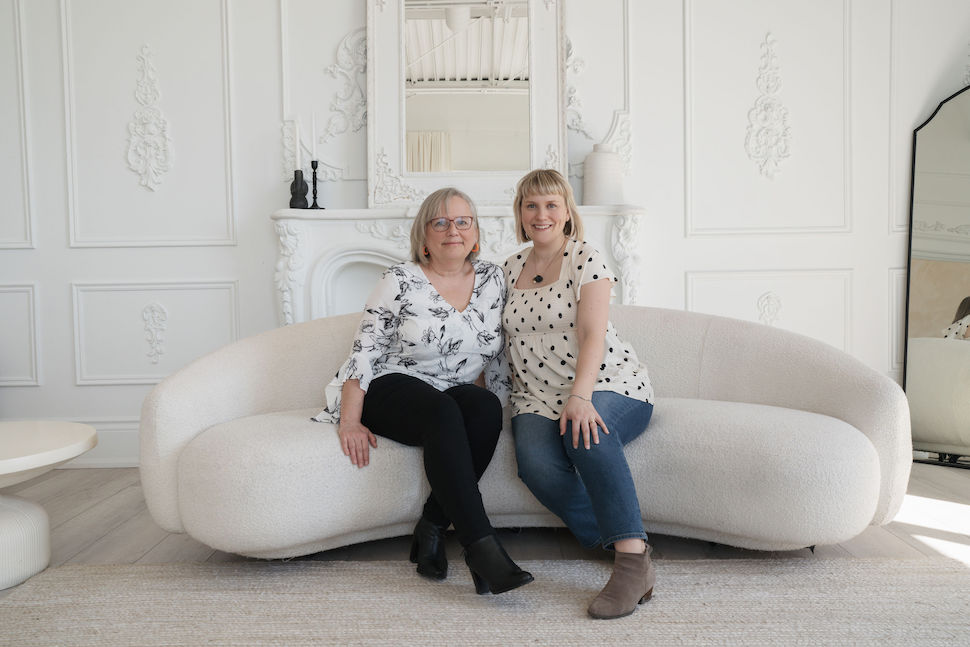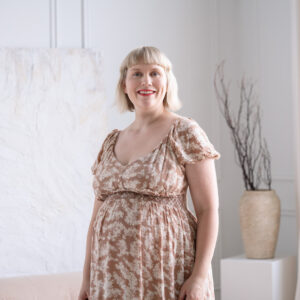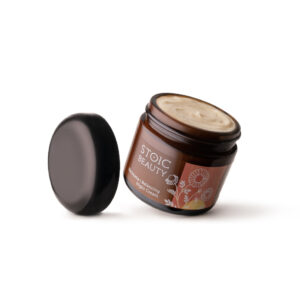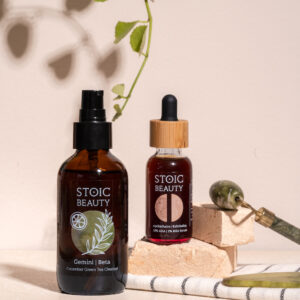
Intrigued with this new skincare line that formulates purely with ingredients that safely biodegrade in water, I spoke at length with Maria Wodzinska, Founder, Stoic Beauty. She and her mother, Jolanta Wodzinska, PhD, an MIT-trained chemist, are on a mission to create Water Safe cosmetic formulations. How do they define water safe? “Water safe means safe for all aquatic life.” explains Maria. “This means that the substance, when released to aquatic ecosystems does not bioaccumulate to toxic levels that can harm the organisms living in this ecosystem. It biodegrades safely without causing any harm to aquatic life. Water safe is a more widely applicable statement than reef safe which refers to safety to coral reefs only.”
You’ve traveled the world and learned from the many cultures you’ve experienced. Tell us about some of your forays and how they’ve influenced who you are today.
I was born in Spain to parents who were fleeing Soviet occupation of Poland, and I grew to love Spanish esthetics with its opulence and warmth. Spain has both Catholic and Moorish influence in art, which is where our logo has its origin. In all cultures there are evil eyes, ours happens to look both iconographically European and Eastern, in line with my love of cultural and symbolic fluidity.
I arrived in Canada when I was very young, and learned English as a second language through the glorious cacophony and noise of school. The experience was overwhelming. I was thought of as “shy” for many years, but it turns out, not at all, I was just taking it all in. As many children of immigrants can understand, speaking a mother tongue at home, and English out in the world, I always thought that my country was just like my mother! Domestically hermetic, familially loyal and, most of all scientific. My mother is intensely focused on the world of small things: molecules, atoms, the invisible strings that tie our universe together.
The most soothing and powerful movement humans can experience is waves.
 I wanted to see the big things, to see the world, and the great drama of life that connects us. So, with dramatic flair, I studied theatre, English, and storytelling. I traveled the world and studied and lived in Paris, journeyed to England and Spain, studied yoga in the Himalayas, experienced Palestine (West Bank), stilt-walked in Dubai, biked solo from Toronto to Cleveland, and took way too many risks and adventures—all to the shock and dismay of my mother, hermetically sealed in her laboratory, working miracles on the small world: developing artificial blood for the AIDS crisis, working with dendritic spines in the brain for Alzheimer’s research, and all sorts of small molecule drug development that I couldn’t possibly slow down long enough to understand.
I wanted to see the big things, to see the world, and the great drama of life that connects us. So, with dramatic flair, I studied theatre, English, and storytelling. I traveled the world and studied and lived in Paris, journeyed to England and Spain, studied yoga in the Himalayas, experienced Palestine (West Bank), stilt-walked in Dubai, biked solo from Toronto to Cleveland, and took way too many risks and adventures—all to the shock and dismay of my mother, hermetically sealed in her laboratory, working miracles on the small world: developing artificial blood for the AIDS crisis, working with dendritic spines in the brain for Alzheimer’s research, and all sorts of small molecule drug development that I couldn’t possibly slow down long enough to understand.
My twenties were filled with theatre, where I worked mostly as a director. I made collaborative pieces in a tradition called “physical theatre” which works with a body-mind relationship of mimicry of the natural world. Our bodies have this incredible kinaesthetic empathy: the ability to mimic in movement what is out in the world. I used this technique and worked with many diverse theatre artists, including many emerging Indigenous performers. Learning with and through them, I remembered that the most soothing and powerful movement humans can experience is waves. Their ebb and flow mimics the liminal space of the womb, and gives a tremendous peace to the body.
When did you begin to focus on water?
Oceans became my healing place when I went a little too far in my creative pursuits and felt hurt by the catastrophes around me. There was the time I went to Palestine in the West Bank to work with some youthful artists and realized they have no access to clean drinking water. Which alighted a very apolitical and agnostic question for me—when, and how, and in what way, can we all protect water as a human right, and protect water as a human person. You see, these artists I worked with had a thing in common—they viewed water as a person. It can be sick, it can be healthy. There began an idea to commit to keep it healthy, so we can all enjoy and live in good ebb and flow. This I did with giant puppets and stilts in public spaces in Toronto—thrilling children with giant river puppets. Calling on the youth to connect to not just the small things, but the big things: our rivers, our one ocean, split into so many, our shared humanity. My mother was terrified. This was a very big call to action, but she supported me always.
When the pandemic struck, I lost almost all of my theatre work overnight. Projects that I had invested years into, communities I was a part of, friendships that were decades old dissipated. I was overcome with salt water tears. But my mother—the ever-stoic person who can see the world in a microscope—told me to come to her lab. We made creams. I recovered my sense of myself, my own beauty through first caring for myself. We made our product Harmonia to help me and my aunt with rosacea flares that arose under stress. And as we made these creams, my mother commented, “It’s so strange how in pharmacology I have to research how medicines will interact with water systems, but in cosmetics I don’t.”
And then the aha moment happened! I realized I can live my mission of safe water through another vehicle, working with my mother, to bring her molecule-bending genius to the world with my big ideas and open heart.
In our initial conversation, you spoke of the impact that coral has had on you. Please share more about this.
The coral. My mother and father brought me to resorts in Mexico when I was most depleted from my theatrical/activism work. When we were swimming and snorkeling in the sea, it was actually my father who noticed that the coral was becoming whiter year after year—it was bleaching. This really broke my heart. My father, off-handedly, commented, “Wouldn’t it be wonderful if we could mimic nature to create a sunscreen that wouldn’t harm the reefs.” Aha! I know about mimicry! I learned how to mimic movement for years and years, surely the genius of my mother could find a mimicry in nature for a natural sunscreen! So, this is the ultimate goal—to create the world’s first verifiably reef-safe, ocean-safe, water-safe UV filter to add to sunscreens, which are not currently harmless to our water systems, and especially our coral forests.
How do you define water-safe skincare?
 Water safe means safe for all aquatic life. This means that the substance, when released to aquatic ecosystems does not bioaccumulate to toxic levels that can harm the organisms living in this ecosystem. It biodegrades safely without causing any harm to aquatic life. Water safe is a more widely applicable statement than reef safe which refers to safety to coral reefs only.
Water safe means safe for all aquatic life. This means that the substance, when released to aquatic ecosystems does not bioaccumulate to toxic levels that can harm the organisms living in this ecosystem. It biodegrades safely without causing any harm to aquatic life. Water safe is a more widely applicable statement than reef safe which refers to safety to coral reefs only.
Water safe is the standard my mother and I created for ourselves. We started with meeting all clean beauty standards that we could find: EWG, Eco-cert, COSMOS approved—and also retail-based standards, such as Credo’s standard and Clean at Sephora. What we found is that there are two filters that these ingredients are not put through: “Will this ingredient biodegrade well in water systems” and “Will this ingredient bioaccumulate in aquatic life.” And the truth is, for many ingredients, we don’t know the answers. This can be because there is underfunded or incomplete research.
So, ever-stoic, we just said, “any doubt, it’s out.” We just do not formulate with any ingredient that has insufficient evidence for water safety. A great example is silicones. They are excellent emollients and improve the skin feel of products. They are safe on the body, and there is no reason from a health standpoint to avoid them. But! They have been shown to bioaccumulate in small aquatic life. Whether this will cause long-term harm is yet to be determined, but, my motto is “The earth is not our Petri dish.” I am not willing to wait until it is a significant problem to stop using an ingredient if there is a viable alternative. So, we do not formulate with silicones. Nor synthetic fragrance. This can be a challenge, but we welcome this challenge as an opportunity to be leaders for other cosmetic chemists to see what can be done with a little extra effort.
Tell us about your chemist mother and her involvement in the creation of Stoic Beauty.
My mother is truly a researcher. Once she starts down a path there is no stopping her. In her career, she worked in small-molecule drug development as an organic chemist for the pharmaceutical industry. In these 20-plus years, she has always been fascinated by all the natural ingredients that could be synthetically created as medicines, but the pharmaceutical industry overlooks these because the problem is deemed too small to justify the research and development expense of taking something natural, recreating it synthetically, and patenting that new synthetic solution.
Many people intuitively understand that “home” remedies are a mixed bag—some are very helpful, some not so much, some only in a specific context. When we started making creams, my mother wanted to solve real problems—things that caused people suffering because they are uncomfortable in their skin (so, not trying to solve aging!). She applied her scientific rigor for reading the existing literature and focused her attention on plant-based actives that have cultural roots. For example, burdock extract was used in Traditional Chinese Medicine for thousands of years for dry skin conditions. She used burdock as the base of our eczema cream, but she worked to amplify its potency with other scientifically known ingredients: ceramides, vitamin B12, and urea.
You donate 1% to Water First. Tell us what that is and why you became involved.
In my previous life as a theatre director, I worked with a young actor from Six Nations of the Grand River. She helped me understand that even in locations like Six Nations, so close to Brantford and Toronto, access to safe, clean water in Indigenous communities in Canada continues to be a challenge today. These water challenges are complex, and infrastructure and technology alone cannot solve the water crisis. Water First works with indigenous communities to deliver education and training programs that help participants develop technical skills to support employment or further education in the water science fields.
Stoic beauty donates to Water First to support the next generation of indigenous water treatment plant operators and water scientists and to help address water challenges in Indigenous communities sustainably and for the long term. Everyone deserves safe, clean water. And safe water needs skilled people.
You told me about some pretty amazing work with the Indigenous youth program and Water Protectors in Canada. Share more.
 Thank you for asking. I worked with students from the Centre for Indigenous Theatre (CIT) in Toronto, which brings together young Indigenous artists from across Canada (Turtle Island). Seeing their incredible resiliency leaving home to study art making in a city like Toronto, taught me a lot about how to be a good ally. The best advice I received from a gathering of elders in Toronto is to remember that it is always a challenge to live with difference. People experience the world in radically different ways. This can be very intuitive to understand when you think about people who grow up by the ocean and people who live in the prairies (like the students at CIT, from all over), and somehow we lose that nuance to allow for difference in cities which demand a kind of speed and conformity of thinking that is harsh to our bodies.
Thank you for asking. I worked with students from the Centre for Indigenous Theatre (CIT) in Toronto, which brings together young Indigenous artists from across Canada (Turtle Island). Seeing their incredible resiliency leaving home to study art making in a city like Toronto, taught me a lot about how to be a good ally. The best advice I received from a gathering of elders in Toronto is to remember that it is always a challenge to live with difference. People experience the world in radically different ways. This can be very intuitive to understand when you think about people who grow up by the ocean and people who live in the prairies (like the students at CIT, from all over), and somehow we lose that nuance to allow for difference in cities which demand a kind of speed and conformity of thinking that is harsh to our bodies.
Learning from these youth, I realized I had never lived anywhere but cities, so I started seeking out appropriate ways to visit reserves and be in ceremony with the communities I was a part of. There I learned, truly, that Indigenous people know this land in a deeper way than I could even conceive. I have great respect for this kind of knowing.
When did you attend Water is Life Legal Summit, and what impact did it have on you and Stoic Beauty?
It meant the world to me. The key takeaways are that I should stop flying all around the world looking for meaning and purpose in my life. I am here, in Canada, where there is 20 percent of the world’s fresh surface drinking water. Many of these water havens are on Indigenous land, and Canada’s treaty rights (from a legal perspective) should allow for that water to be protected. Unfortunately, even locally in Toronto, major corporations act with impunity, literally stealing fresh water, from reserve land. Water protectors are predominantly women in these communities who speak for the right of the water to be a shared resource for all.
Mary Bemis
Mary Bemis is Founder & Editorial Director of InsidersGuidetoSpas.com. An advocate for all things spa, Mary forged a vocabulary for spa reportage that is widely used by those who cover the issues today. Recently honored as a Top 30 Influential Voice Transforming Wellness by Medika Life, Mary is an inaugural honoree of Folio’s Top Women in Media Award. Her spa media roots run deep—in 1997, she launched American Spa magazine, in 2007, she co-founded Organic Spa magazine, and in between serving on the ISPA and NYSPA Board of Directors, she was on the launch teams of Luxury SpaFinder and New Beauty magazines. Named a "Wonder Woman of Wellness" by American Spa magazine, Mary was honored by the International Spa Association with the distinguished ISPA Dedicated Contributor Award. She is a special advisor to the non-profit Global Wellness Day.
- Web |
- More Posts(89)